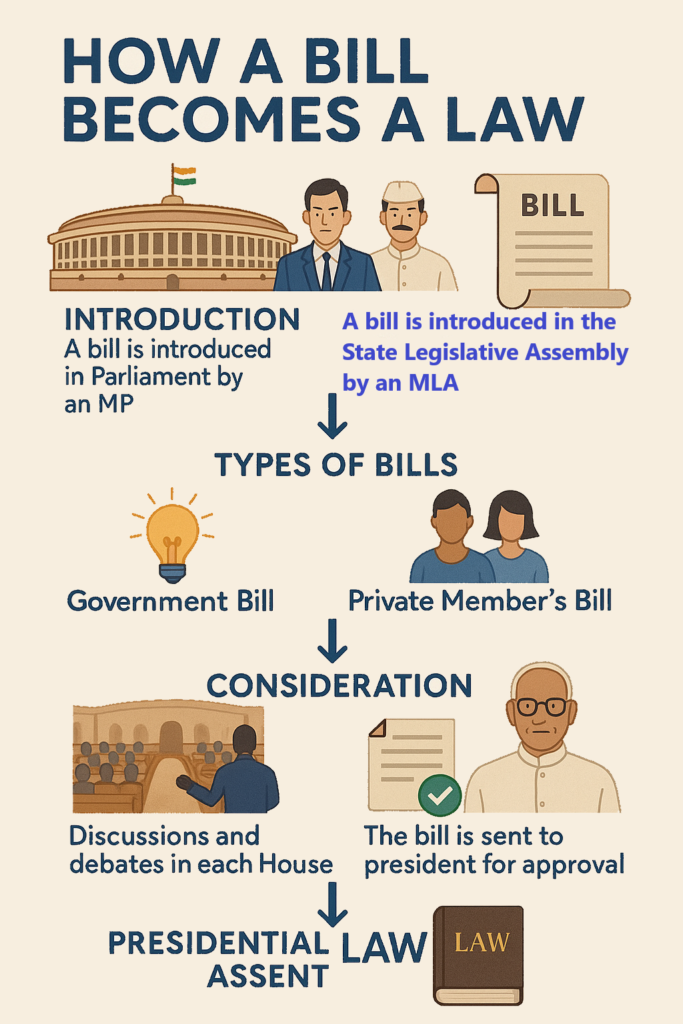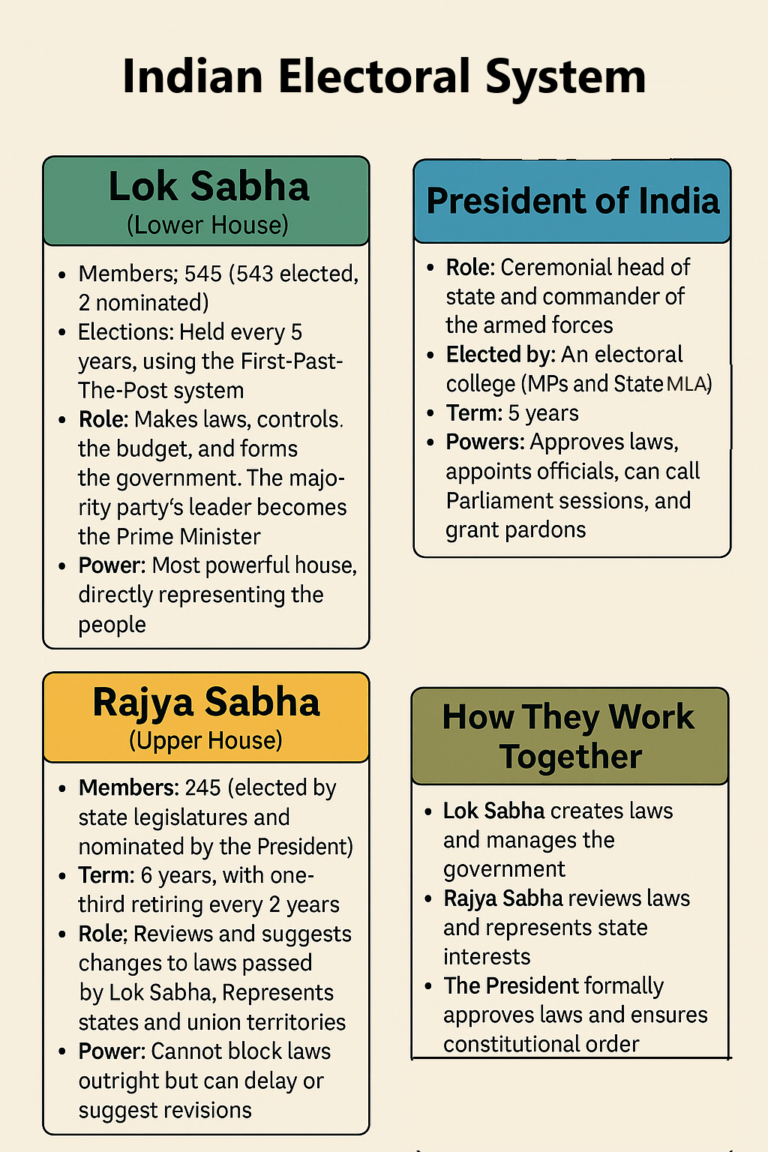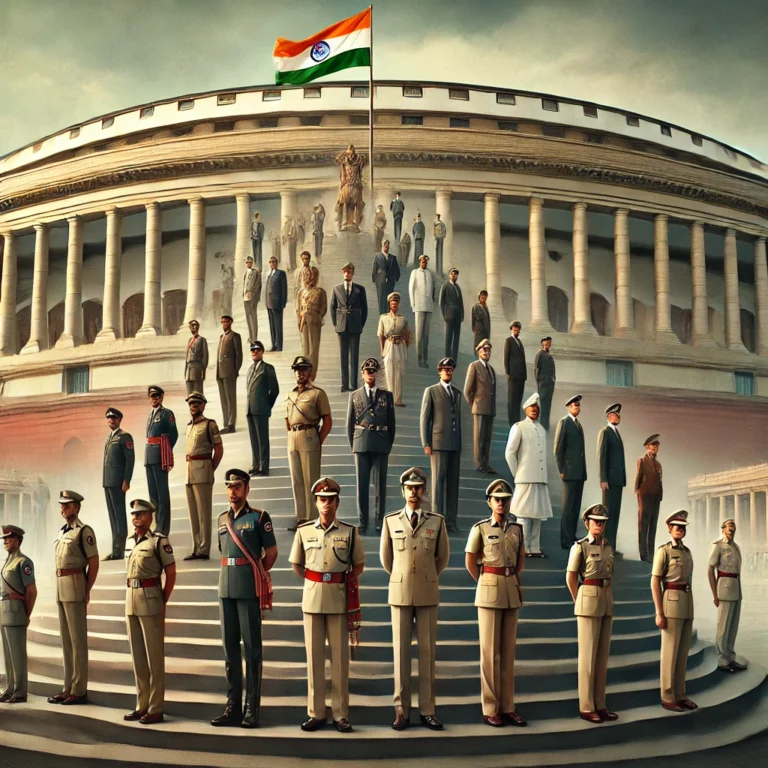The Judiciary in India
The judiciary is a branch of the government in India responsible for interpreting laws and ensuring justice. It is separate from the executive (government) and legislative (law-making) branches, meaning it works independently to make sure that laws are followed and rights are protected.

Structure of the Judiciary in India
The Indian judiciary is structured in a way that makes it easier to deal with different kinds of legal cases. It has three main levels:
- Supreme Court:
- This is the highest court in India, located in New Delhi.
- It has the power to hear appeals from lower courts, handle cases related to the Constitution, and act as the final authority on legal matters in the country.
- The Chief Justice of India (CJI) heads the Supreme Court, and other judges assist in making decisions.
- It also deals with important public interest cases and fundamental rights.
- High Courts:
- Each state or group of states in India has a High Court, which is the second-highest court.
- The High Court can hear appeals from lower courts (district courts), deal with important cases, and make decisions on constitutional matters within the state.
- They are headed by a Chief Justice and have several other judges.
- Lower Courts:
- These are the courts that deal with everyday legal matters at the district and local levels. Examples include:
- District Courts: Handle civil and criminal cases.
- Magistrate Courts: Deal with smaller criminal cases.
- Family Courts, Consumer Courts, and others: Deal with specific types of cases.
- These are the courts that deal with everyday legal matters at the district and local levels. Examples include:
Functions of the Judiciary
The judiciary in India performs several important functions:
- Interpreting Laws:
- The courts explain what laws mean and how they should be applied. If there’s a conflict about how a law should be understood, the judiciary steps in to clarify.
- Resolving Disputes:
- Courts help in resolving conflicts between individuals, businesses, or even between the government and citizens.
- Protecting Fundamental Rights:
- The judiciary ensures that people’s basic rights (like the right to freedom of speech, equality before the law, etc.) are protected under the Constitution.
- If someone feels their rights are violated, they can approach the courts for justice.
- Judicial Review:
- The courts have the power to review laws and government actions. If any law or action is found to be against the Constitution, the judiciary can declare it “unconstitutional” and strike it down.
- Ensuring Rule of Law:
- The judiciary ensures that everyone, including the government, follows the law. No one is above the law.
Independence of the Judiciary
The independence of the judiciary is a very important part of the Indian legal system. This means that judges are free to make decisions based on the law and facts of a case, without interference from the government or other powerful bodies. Here’s how independence is maintained:
- Security of Tenure:
- Judges are appointed for fixed terms, and once appointed, they can only be removed through a special process (like impeachment) which is very difficult. This protects them from being influenced by the government.
- Separation from the Executive:
- The judiciary is separate from the government, so the government cannot control or influence court decisions.
- Financial Independence:
- The judiciary has its own budget, and it is not dependent on the government for funding. This helps protect its independence.
- Appointments of Judges:
- Judges are appointed by a collegium of senior judges rather than the government, to reduce political interference.
Conclusion
To sum it up, the judiciary in India ensures justice by interpreting laws, resolving disputes, protecting rights, and maintaining the rule of law. It operates at three levels: the Supreme Court (highest), High Courts (state-level), and lower courts. Its independence is crucial for upholding the Constitution and ensuring fairness in legal matters.










